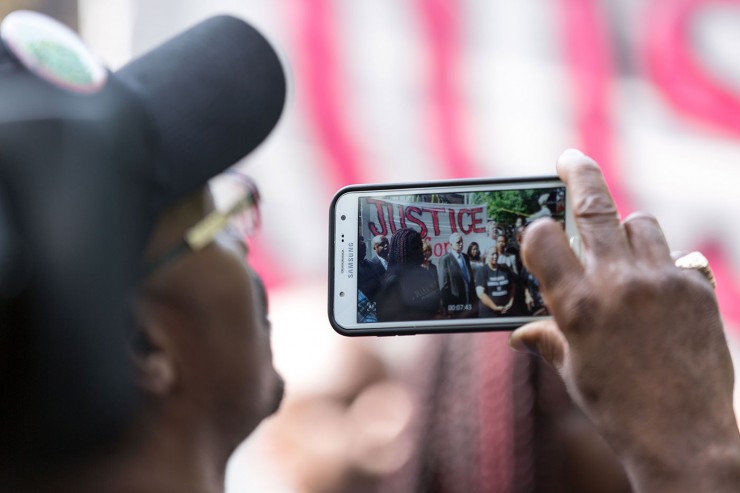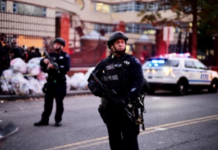
On Tuesday night, Alton Sterling was fatally shot by police in Baton Rouge, Louisiana. Late Wednesday, Philando Castile died after being shot by police during a traffic stop in the St. Paul, Minnesota, suburb of Falcon Heights. Both men were black, and the shootings have touched off a series of protests across the country.
And then, on Thursday, a third day of violence. At a peaceful protest in Dallas, five police officers were killed and nine others injured by snipers.
The shootings in Louisiana and Minnesota, and the ambush in Dallas, were captured in grisly videos by bystanders—videos that quickly circulated on social media.
Here, law professor Jessica Silbey, an expert on intellectual property and the use of film to communicate about law, talks about the role technology—particularly video footage—now plays in influencing the national conversation about race and policing, the constitutional rights of citizens to film police activity, and the value of bystander videos in investigations and trials.
What roles have technology, cellphone videos in particular, and social media had on influencing the national dialogue about race and policing?
Certainly, digital technology has increased the speed at which information travels. And the diversity of information—different videos of the same event for example—is also more readily available. This can help people understand that the more viewpoints on an event, the richer the debate with more people involved. This is good for a society that is supposed to be based on democratic principles of representativeness, accountability, and self-government.
Unfortunately, I don’t see the ubiquity of videos changing people’s minds about particular events. People come to video images with a framework of understanding and experience that shapes what they see. Sometimes videos solidify preconceived notions. And sometimes they complicate the understanding of what happened. Rarely do they answer with certainty the central issue, e.g., whether the police used an unconstitutional amount of force. In the Baton Rouge video, for example, the video does not help us understand if Mr. Sterling had a gun in his pocket and if he did, if he was reaching for it. It doesn’t help us understand why the police officers appeared threatened by the victim. Those who understand the pervasive and traumatic epidemic of racial profiling in the United States know that the Baton Rouge police officers felt threatened by Mr. Sterling because he is black and there was a 911 call reporting a black man threatening a person with a gun in that parking lot. To them, the video will confirm an unlawful use of force against a man who was not a threat and, more generally, serves as evidence of the ongoing slaughter of black men by police officers in this country. But not all people will see that in the video.
Do everyday citizens have a constitutional right to film police activity and post it online?
In general, citizens have the right to record and photograph law enforcement in public. This is especially true when the recording is used to criticize the police. There is no Supreme Court case directly on point, but most lower federal courts have come to this same conclusion. Posting the video online is also protected speech under the First Amendment, with some exceptions for the privacy of the civilians involved. It is possible for a civilian who is a subject of the video to bring a privacy claim against the poster of the video if the images in the video are particularly traumatic or upsetting. Many such private suits will turn on the newsworthiness of the images.
What impact does footage recorded by bystanders have on an investigation? Is it afforded the same consideration and does it carry the same weight as other forms of evidence?
Typically, video footage recorded by a neutral bystander is strong evidence if the facts that are in dispute are resolved by the video. This is not always the case, however. Video footage can also help corroborate witness testimony and support the credibility of witnesses. These uses are much more helpful. Videos rarely “speak for themselves” and need—or should have—an eyewitness (or several) to help narrate the scene with the images. Moreover, bystander videos are often grainy and shaky, and the sound is poor. That makes them more ambiguous than one would hope when seeking to prove wrongdoing or exonerate a defendant. Perhaps as importantly, however, video footage has significant persuasive force as a symbol of witnessing, of citizens being present during altercations or critical events that deserve public scrutiny. Video footage like those from Baton Rouge and St. Paul this week are so powerful as evidence that says “I bear witness.” Bearing witness like that—and calling for others to do the same—can be critical for mobilization and political change, even when the content of the video itself may be contested.
In Baton Rouge, there are public calls for the release of surveillance footage seized as evidence. What guidelines govern if and when evidence is released publicly?
Laws in each state address the release of public records, and police departments usually have existing policies and people to deal with public records requests. Video evidence presents new problems, however, and working groups have formed all over the country to update the guidelines about retention and release of video footage. On the one hand, police departments consider issues around preserving the integrity of the investigation. On the other hand, retention and release guidelines must also serve to maintain public trust and accountability. It’s a hotly debated topic right now, especially with body cameras that record images of confrontations in homes and other private spaces. When footage shot by citizens is seized by the police as relevant evidence pursuant to a warrant, for example, it becomes part of the record in the case and usually is subject to the same kind of public records policies.
(Reprinted with permission from News at Northeastern University.)














